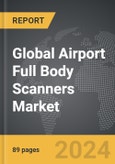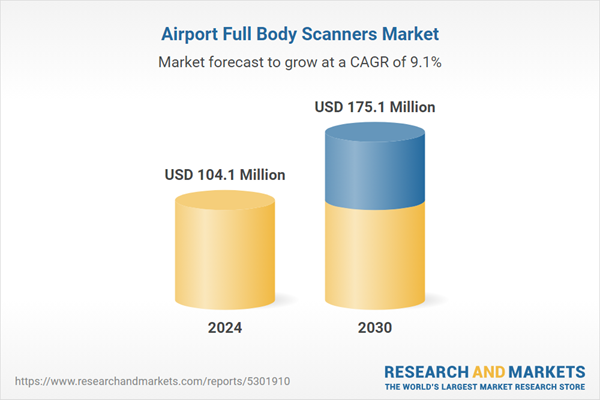Global Airport Full Body Scanners Market - Key Trends and Drivers Summarized
Why Are Airport Full Body Scanners Becoming a Standard Security Measure?
Airport full body scanners have emerged as a key element in modern airport security protocols, but what specific factors have driven their widespread adoption? In the increasingly complex world of air travel, the need for heightened security measures has grown in response to the evolving tactics of global terrorism and other security threats. Traditional security devices, such as metal detectors, are limited in their ability to detect non-metallic items like explosives, ceramic weapons, or plastic-based contraband. Full body scanners, which use either millimeter-wave or backscatter X-ray technology, offer a more comprehensive detection method by identifying both metallic and non-metallic objects concealed under clothing. This expanded detection capability has made full body scanners essential for intercepting threats that might otherwise go unnoticed, thus enhancing passenger safety. Moreover, the sheer volume of air travelers worldwide has surged, placing tremendous pressure on airport infrastructure to maintain both high security and operational efficiency. Full body scanners help to streamline the security process, reducing the need for more invasive manual checks and speeding up the flow of passengers through checkpoints. The scanners' ability to quickly and accurately scan passengers without requiring physical pat-downs has made them not only more effective but also more convenient for passengers and security personnel alike. In addition to their efficiency and effectiveness, full body scanners have become a symbol of airports' commitment to adopting cutting-edge technologies to keep pace with emerging security threats, positioning them as a standard feature in airports globally.How Do Full Body Scanners Work and What Technology Do They Use?
The functionality of airport full body scanners is rooted in sophisticated technology, but how do they operate to ensure enhanced security? There are two primary types of scanners in use: millimeter-wave scanners and backscatter X-ray scanners, each utilizing different methods to detect concealed items. Millimeter-wave scanners operate by emitting radio waves that bounce off the body and create a detailed, three-dimensional image. These waves penetrate clothing but not the skin, allowing the system to identify objects hidden under a person's clothes. What sets millimeter-wave technology apart is its ability to detect a range of materials, including plastics, liquids, and ceramics, which are often used in non-metallic explosives. These scanners are preferred in many airports because they do not emit ionizing radiation, which is a major consideration for frequent travelers and airport personnel. Backscatter X-ray scanners, on the other hand, use low-dose X-rays to create a two-dimensional image of a person's body. These X-rays bounce off organic and inorganic materials differently, allowing the system to highlight suspicious objects by contrasting the density of various materials. While backscatter X-ray scanners were initially popular due to their accuracy, concerns about the potential health risks associated with even low levels of ionizing radiation have led many airports to favor millimeter-wave scanners instead. Both types of scanners are designed to detect concealed weapons, explosives, or prohibited items that metal detectors cannot identify, and recent advancements in image processing software now allow the technology to differentiate between benign items and actual threats with greater accuracy. This progress minimizes the need for manual inspections and further accelerates the screening process, making full body scanners an integral part of the modern airport security landscape.What Are the Privacy and Health Concerns Associated with Full Body Scanners?
While full body scanners have enhanced security measures, their use has not been without controversy, particularly in relation to privacy and health. How have these concerns been addressed to balance safety with individual rights? Initially, there was significant public resistance to full body scanners because early models produced highly detailed images of passengers' bodies, which many perceived as intrusive and a violation of personal privacy. These images, though viewed only by security personnel, sparked widespread debate about the extent to which privacy should be sacrificed for safety. In response to these concerns, airports and manufacturers quickly adapted by implementing software that transforms the detailed body images into generic, avatar-like representations. These avatars highlight only potential threats, rather than revealing an exact likeness of the individual, which has largely mitigated the privacy concerns that originally surrounded the technology. Health concerns have also played a pivotal role in the conversation surrounding full body scanners, particularly those that use backscatter X-ray technology. The fact that backscatter scanners emit ionizing radiation, even at low doses, raised alarms among frequent travelers, pilots, and health advocates who feared the cumulative effects of exposure. Although health authorities have generally deemed these radiation levels safe, many airports have opted for millimeter-wave scanners, which use non-ionizing radio waves and are considered harmless. This transition has helped address health-related fears, especially as the technology becomes more widespread. Moreover, the scanners themselves are constantly being refined to improve both their safety profile and efficiency, further easing public concern.What's Driving the Global Adoption of Full Body Scanners in Airports?
The growth of full body scanners in airports worldwide is being fueled by a variety of factors, ranging from evolving security threats to technological advancements and operational efficiencies. The primary driver of this adoption is the increasingly sophisticated methods employed by those attempting to bypass traditional airport security systems. In the face of new, non-metallic threats like plastic explosives or concealed liquid explosives, metal detectors and conventional screening methods are no longer sufficient. Full body scanners, with their ability to detect a wide range of concealed objects, have become essential tools in addressing these emerging threats and preventing potential attacks. This need for heightened security has led to widespread regulatory mandates, with aviation authorities across the globe requiring airports to upgrade their screening technologies to meet international security standards. In addition to security concerns, advances in full body scanning technology itself have made these systems more efficient and affordable for airports to adopt. Innovations in image processing, threat detection algorithms, and scanner design have reduced the time it takes to screen passengers, thereby improving the overall passenger experience while maintaining high security standards. Airports are increasingly under pressure to process larger numbers of travelers without causing delays, and full body scanners offer a solution that balances security with operational efficiency. Furthermore, the growth of global air travel, particularly in emerging markets, has necessitated the adoption of cutting-edge security infrastructure to ensure that airports can handle the increasing volume of passengers while maintaining strict safety protocols. Finally, the global push toward seamless travel, where passengers can move through airports with minimal disruptions, has also played a role in the adoption of full body scanners. As part of broader efforts to modernize and streamline airport operations, full body scanners are viewed as a way to enhance security without causing significant slowdowns at checkpoints. With their ability to provide fast, non-invasive scans that detect a wide range of threats, these scanners have become a crucial tool in ensuring both security and convenience, making their global adoption inevitable.Report Scope
The report analyzes the Airport Full Body Scanners market, presented in terms of market value (US$ Thousand). The analysis covers the key segments and geographic regions outlined below.- Segments: Technology (Millimeter Radio-Wave Scanner, Backscatter X-Ray Scanner).
- Geographic Regions/Countries:World; United States; Canada; Japan; China; Europe (France; Germany; Italy; United Kingdom; and Rest of Europe); Asia-Pacific; Rest of World.
Key Insights:
- Market Growth: Understand the significant growth trajectory of the Millimeter Radio-Wave Scanner segment, which is expected to reach US$125.4 Million by 2030 with a CAGR of a 9.5%. The Backscatter X-Ray Scanner segment is also set to grow at 8.1% CAGR over the analysis period.
- Regional Analysis: Gain insights into the U.S. market, valued at $31.5 Million in 2024, and China, forecasted to grow at an impressive 7.9% CAGR to reach $29.1 Million by 2030. Discover growth trends in other key regions, including Japan, Canada, Germany, and the Asia-Pacific.
Why You Should Buy This Report:
- Detailed Market Analysis: Access a thorough analysis of the Global Airport Full Body Scanners Market, covering all major geographic regions and market segments.
- Competitive Insights: Get an overview of the competitive landscape, including the market presence of major players across different geographies.
- Future Trends and Drivers: Understand the key trends and drivers shaping the future of the Global Airport Full Body Scanners Market.
- Actionable Insights: Benefit from actionable insights that can help you identify new revenue opportunities and make strategic business decisions.
Key Questions Answered:
- How is the Global Airport Full Body Scanners Market expected to evolve by 2030?
- What are the main drivers and restraints affecting the market?
- Which market segments will grow the most over the forecast period?
- How will market shares for different regions and segments change by 2030?
- Who are the leading players in the market, and what are their prospects?
Report Features:
- Comprehensive Market Data: Independent analysis of annual sales and market forecasts in US$ Million from 2024 to 2030.
- In-Depth Regional Analysis: Detailed insights into key markets, including the U.S., China, Japan, Canada, Europe, Asia-Pacific, Latin America, Middle East, and Africa.
- Company Profiles: Coverage of players such as American Science & Engineering Group, Braun & Company, Brijot Imaging Systems (Microsemi), CST Digital Communications, L-3 Communications Holdings, Inc. and more.
- Complimentary Updates: Receive free report updates for one year to keep you informed of the latest market developments.
Some of the 34 companies featured in this Airport Full Body Scanners market report include:
- American Science & Engineering Group
- Braun & Company
- Brijot Imaging Systems (Microsemi)
- CST Digital Communications
- L-3 Communications Holdings, Inc.
- Millivision Inc.
- Morpho (Safran)
- Rapiscan Systems Ltd.
- Smiths Group PLC
- Tek84 Engineering Group LLC
This edition integrates the latest global trade and economic shifts into comprehensive market analysis. Key updates include:
- Tariff and Trade Impact: Insights into global tariff negotiations across 180+ countries, with analysis of supply chain turbulence, sourcing disruptions, and geographic realignment. Special focus on 2025 as a pivotal year for trade tensions, including updated perspectives on the Trump-era tariffs.
- Adjusted Forecasts and Analytics: Revised global and regional market forecasts through 2030, incorporating tariff effects, economic uncertainty, and structural changes in globalization. Includes historical analysis from 2015 to 2023.
- Strategic Market Dynamics: Evaluation of revised market prospects, regional outlooks, and key economic indicators such as population and urbanization trends.
- Innovation & Technology Trends: Latest developments in product and process innovation, emerging technologies, and key industry drivers shaping the competitive landscape.
- Competitive Intelligence: Updated global market share estimates for 2025, competitive positioning of major players (Strong/Active/Niche/Trivial), and refined focus on leading global brands and core players.
- Expert Insight & Commentary: Strategic analysis from economists, trade experts, and domain specialists to contextualize market shifts and identify emerging opportunities.
Table of Contents
Companies Mentioned (Partial List)
A selection of companies mentioned in this report includes, but is not limited to:
- American Science & Engineering Group
- Braun & Company
- Brijot Imaging Systems (Microsemi)
- CST Digital Communications
- L-3 Communications Holdings, Inc.
- Millivision Inc.
- Morpho (Safran)
- Rapiscan Systems Ltd.
- Smiths Group PLC
- Tek84 Engineering Group LLC
Table Information
| Report Attribute | Details |
|---|---|
| No. of Pages | 115 |
| Published | December 2025 |
| Forecast Period | 2024 - 2030 |
| Estimated Market Value ( USD | $ 104.1 Million |
| Forecasted Market Value ( USD | $ 175.1 Million |
| Compound Annual Growth Rate | 9.1% |
| Regions Covered | Global |









